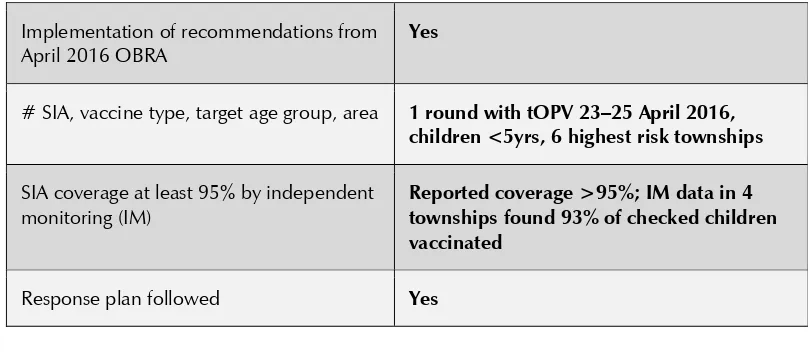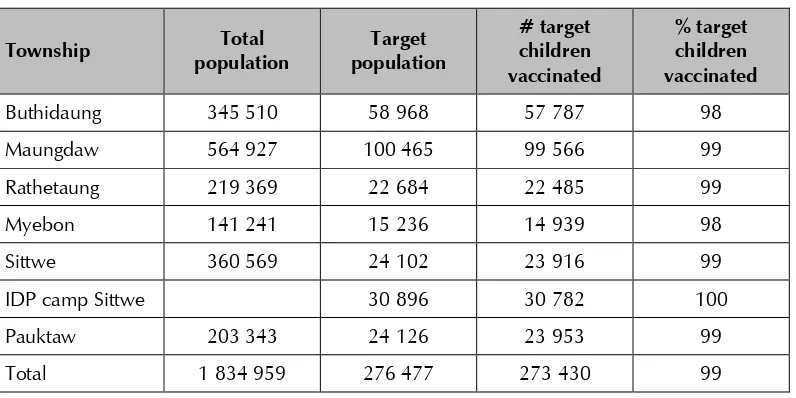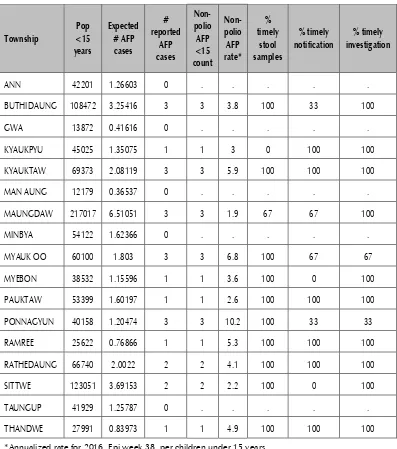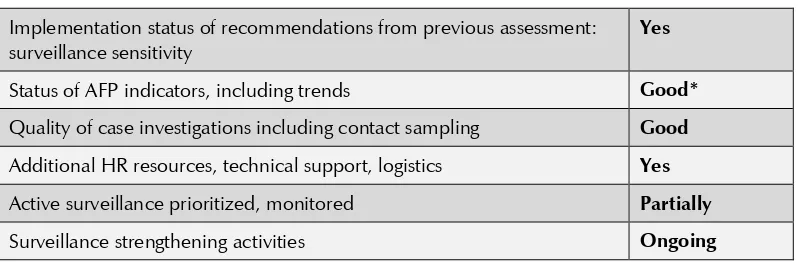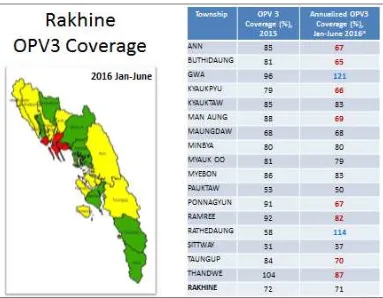SEA-Immun-106 Distribution: General
External Second Assessment:
Circulating Vaccine Derived
Poliovirus Type 2 (cVDPV2)
Outbreak Response
© World Health Organization 2016
All rights reserved.
Requests for publications, or for permission to reproduce or translate WHO publications – whether for sale or for noncommercial distribution – can be obtained from SEARO Library, World Health Organization, Regional Office for South-East Asia, Indraprastha Estate, Mahatma Gandhi Marg, New Delhi 110 002, India (fax: +91 11 23370197; e-mail: [email protected]).
The designations employed and the presentation of the material in this publication do not imply the expression of any opinion whatsoever on the part of the World Health Organization concerning the legal status of any country, territory, city or area or of its authorities, or concerning the delimitation of its frontiers or boundaries. Dotted lines on maps represent approximate border lines for which there may not yet be full agreement.
The mention of specific companies or of certain manufacturers’ products does not
imply that they are endorsed or recommended by the World Health Organization in preference to others of a similar nature that are not mentioned. Errors and omissions excepted, the names of proprietary products are distinguished by initial capital letters.
All reasonable precautions have been taken by the World Health Organization to verify the information contained in this publication. However, the published material is being distributed without warranty of any kind, either expressed or implied. The responsibility for the interpretation and use of the material lies with the reader. In no event shall the World Health Organization be liable for damages arising from its use. This publication does not necessarily represent the decisions or policies of the World Health Organization.
Maps disclaimer
Contents
Page
Acronyms ... v
Executive summary ... vii
1. Objectives of the follow-up outbreak response assessment ... 1
2. Background ... 1
3. Methodology of the outbreak response assessment: ... 2
4. Observations and conclusions of the assessment teams ... 6
5. Conclusions ... 22
6. Recommendations ... 24
7. Acknowledgement ... 25
Acronyms
AFP Acute flaccid paralysis
BMGF Bill & Melinda Gates Foundation
bOPV Bivalent oral poliovirus vaccine
cVDPV Circulating vaccine-derived poliovirus
IDP Internally displaced population
IHR International Health Regulation (2005)
IM Independent monitoring
INGO International nongovernmental organization
IPV Inactivated poliovirus vaccine
NCCPE National Certification Committee for Polio Eradication
NGO Nongovernmental organization
NITAG National Immunization Advisory Group
NPAFP Non-polio AFP
NPL National polio laboratory
OBRA Outbreak response assessment
OPV Oral poliovirus vaccine
POL3 Polio immunization, third dose
PHS Public health supervisor
RCA Rapid coverage assessment
RCCPE Regional Certification Commission for Polio Eradication
REC Reaching every community
RHC Rural health centre
SC Subcentre(health)
SCDU Special Diseases Control Unit
SEARO WHO South-East Asia Regional Office
SIA Supplementary immunization activity
TBA Traditional birth attendant
tOPV Trivalent oral poliovirus vaccine
UNICEF United Nations Children’s Fund
US CDC US Centers for Disease Control and Prevention
VPD Vaccine preventable disease
WHO World Health Organization
Executive summary
Following confirmation of a circulating vaccine-derived poliovirus (cVDPV) type 2 in Rakhine State, Myanmar, in December 2015 and subsequent response measures, an external outbreak response assessment (OBRA) was conducted from 28 March to 5 April 2016. It mainly identified requirements for strengthening acute flaccid paralysis surveillance and conducting a 5th round of supplementary immunization activities (SIA) with trivalent oral poliovirus vaccine to further close immunity gaps.
The subsequent assessment was conducted in conjunction with a comprehensive ‘EPI and Vaccine Preventable Disease Surveillance Review’ from 26 September to 8 October 2016. The main rationale for combining both activities was a common area of focus on children missed during vaccination, how to address this situation, the ability of surveillance to detect cases, particularly acute flaccid paralysis (AFP) cases, and how to strengthen future routine immunization and surveillance in a broader context.
Three of the 11 review teams representing the Ministry of Health and Sports, WHO, UNICEF, the US Centers for Disease Control and Prevention (US CDC), sensitivity sufficient to detect transmission.
While children identified during IM RCA as not having been vaccinated during the SIA were immunized by the monitoring teams, results suggest that some areas were not as well covered as reported coverage is indicating. Routine immunization in Rakhine State achieved again 100% area access, with some initial positive coverage trends – however, large immunity gaps have accumulated in the past.
Improvements in the AFP surveillance quality in Rakhine State in 2016 are adequate to reasonably conclude that cVDPV2 transmission has ceased. Interruption of transmission is further supported by no further VDPV2 cases reported since October 2015 while additional surveillance measures are being implemented such as contact sampling from AFP cases. It is assumed that five SIA rounds from December 2015 to April 2016 reporting high coverage have increased population immunity in young children. The AFP surveillance quality in other parts of the country has also been strengthened to levels that are unlikely to miss ongoing poliovirus transmission.
1.
Objectives of the follow-up outbreak response
assessment
To assess whether the quality and adequacy of polio outbreak response activities are sufficient to interrupt poliovirus transmission, as per World Health Assembly (WHA) established standards, including status of implementation of previous assessment recommendations.
To provide additional technical recommendations to assist the country to meet this goal.
2.
Background
Following confirmation of a circulating vaccine-derived poliovirus (cVDPV) type 2 in Rakhine State, Myanmar, in December 2015 and subsequent response measures, an external outbreak response assessment (OBRA) was conducted from 28 March to 5 April 2016. Conclusions included that the overall response by the national authorities, with support from WHO and UNICEF regional and country offices, had been strong and appropriate following the confirmation of the outbreak.
The overall planning for and quality of SIAs were considered good and in accordance with WHA guidelines. Adequate funds and other logistics had been ensured to implement the planned outbreak response activities. The SIAs were evaluated by international monitors from various organizations.
However, routine immunization coverage was found to be suboptimal, especially in the outbreak area. As such, it was concluded that the transmission of cVDPV2 may have been interrupted but uncertainty in concluding this remained due to gaps in AFP surveillance quality in Rakhine State and other areas in Myanmar. An urgent need to address the gaps identified was highlighted as the risk of further cVDPV2 transmission after the switch from tOPV to bivalent OPV (bOPV) in April 2016 would have global implications.
3.
Methodology of the outbreak response
assessment
As the 3-month OBRA conducted earlier in 2016 had mainly identified requirements for strengthening AFP surveillance performance and conducting a 5th tOPV SIA to further close immunity gaps, the subsequent OBRA was conducted in conjunction with a joint national/international ‘EPI and Vaccine Preventable Disease (VPD) Surveillance Review’ carried out in Myanmar from 26 September to 8 October 2016.
External Second Assessment: Circulating Vaccine Derived Poliovirus Type 2 (cVDPV2) Outbreak Response
In aiming at the following broad areas, the ‘EPI and VPD Surveillance Review’ also targeted key areas for maintaining polio-free status:
To understand which children in Myanmar are not being fully immunized and the reasons this is occurring;
To determine if the VPD surveillance system meets national and global targets and is currently able to detect any VPD outbreaks;
To determine if the strategies being implemented for achieving measles elimination and rubella/congenital rubella syndrome control targets by 2020 are adequate to reach the targets;
To assess how EPI strategies and capacities need to be strengthened to sustain polio-free status and maternal and neonatal tetanus elimination, accelerate hepatitis B control and uniformly increase coverage for all routine vaccines.
The main rationale for combining both activities was a common area of focus on children missed in vaccination, how to address this situation, the ability of VPD surveillance to detect cases, particularly AFP cases, and how to strengthen future routine immunization and VPD surveillance in a broader context. Combining both activities also allowed increasing efficiencies and resource utilization. Three of the 11 teams visited Rakhine and Shan South States with specific OBRA objectives; an additional focus
OBRA team compositions and assigned areas
Team 1 (Shan South State)
- Dr Jeff Partridge, BMGF
- Dr Tin Thitsar Lwin, Epidemiologist, Regional Department of Public Health Yangon
- Dr Myat Phyu Pyar Aye, Teal Leader, Special Diseases Control Unit (SDCU) Tanintharyi Regional Public Health Department
Team 2 (Rakhine State: Maungdaw, Buthidaung)
- Dr Graham Tallis, WHO HQ
- Dr Cynthia Snider, US CDC
- Dr Sai Win Zaw Hlaing, Deputy State Health Director, Shan State South, Department of Public Health
- Dr Aung Naing Oo, Assistant Director, central EPI Unit, Department of Public Health
- Dr Phone Myat Hein, Team Leader, SDCU Yangon Regional Public Health Department
- Dr Thiha Htun, UNICEF Country Office
Team 3 (Rakhine State: Sittwe, Rathedaung)
- Dr Sigrun Roesel, WHO SEARO
- Dr Aye Mya Chan Thar, Assistant Director, central EPI Unit, Department of Public Health
- Dr Thit Thit Nwe, Team Leader SDCU, Mon State Public Health Department
The review teams used a number of methods to inform their findings, including:
External Second Assessment: Circulating Vaccine Derived Poliovirus Type 2 (cVDPV2) Outbreak Response
Interviews with relevant stakeholders including health officials, health facility staff, caregivers on topics such as planning, implementation and supervision-monitoring systems, including the feedback mechanism;
Data tracking at all levels for data quality and consistency;
Site visits to assess service delivery and related aspects;
Hospital visits to assess VPD surveillance;
Review of national advisory and oversight bodies, e.g., National Immunization Technical Advisory Group (NITAG), National Certification Committee for Polio Eradication (NCCPE), National Taskforce for Poliovirus Laboratory Containment.
Six key areas were assessed to evaluate whether the outbreak response complied with WHA-established standards:
(1) Did the outbreak response activities meet the required standards and adequately address the recommendations of the 3-month OBRA?
(2) Has the additional SIA recommended during the 3-month OBRA been of quality sufficient to ensure that poliovirus transmission is interrupted?
(3) Has the AFP surveillance system been strengthened to a level of sensitivity sufficient to detect transmission?
(4) Have the polio outbreak response activities been undertaken in a manner that would strengthen routine immunization performance, particularly in the highest risk areas?
(5) Have sufficient financial, material and human resources been made available to support full implementation of all recommended polio outbreak response activities?
(6) Were any remaining risks identified to stopping the outbreak?
4.
Observations and conclusions of the assessment
teams
4.1
Did the outbreak response activities meet the polio outbreak
response standards and responded adequately to the
recommendations of the 3-month OBRA?
Recommendations of the 3-month OBRA were implemented in line with polio outbreak response standards (refer to Table 1). An additional 5th SIA with tOPV was conducted 23–25 April 2016 targeting children under 5 years in the six highest risk townships in Rakhine State; also in the outbreak-affected townships of Maungdaw in Buthidaung, Myebone, Pauktaw, Rathedaung and Sittwe (refer to Figure 1). Selection criteria included cVDPV2 outbreak area and geographical proximity, low routine immunization and AFP surveillance performance, a large percentage of Muslim population and internally displaced people (IDP) camp and measles outbreaks in 2016. The reported coverage was over 95%, and independent monitoring found 93% of children checked vaccinated in four of the six townships.
External Second Assessment: Circulating Vaccine Derived Poliovirus Type 2 (cVDPV2) Outbreak Response
Figure 1: Polio SIAs in Rakhine, 2015–2016
Round I Round II Round III Round IV Round V
Source: WHO South East Asia Region data as of September 2016
Table 1: Summary on speed and appropriateness of outbreak response activities after 3-month OBRA
Implementation of recommendations from April 2016 OBRA
Yes
# SIA, vaccine type, target age group, area 1 round with tOPV 23–25 April 2016, children <5yrs, 6 highest risk townships
SIA coverage at least 95% by independent monitoring (IM)
Reported coverage >95%; IM data in 4 townships found 93% of checked children vaccinated
4.2
Has the additional SIA recommended during the 3-month
OBRA been of quality sufficient to ensure that poliovirus
transmission is interrupted?
Strong partner coordination continued as in previous rounds; and while fund release occurred in May 2016, it did not compromise SIA conduct. The short preparation time was compensated by technical assistance support from the central EPI and WHO and UNICEF country offices, assigning at least one staff per township. Micro-planning, social mobilization, advocacy, coordination and monitoring capacities established during the previous 4 SIAs benefited quality implementation of this round.
The SIA duration was extended to 5–6 days in several places to achieve high coverage. While December 2015 SIA target figures were used to report coverage, several places used the number of children vaccinated in previous SIAs (if higher than target) for operational planning. No vaccine and supply shortages were reported, and refusals were the exception (some concerns were expressed in Buthidaung). The SIA achieved 100% area access and was largely carried out in a house-to-house approach, with additional temporary posts in strategic locations or where house-to-house vaccination was not possible, mainly due to security concerns. Vaccination posts were also established at border crossing points as per recommendations of the 3-month OBRA.
External Second Assessment: Circulating Vaccine Derived Poliovirus Type 2 (cVDPV2) Outbreak Response
Table 2: Reported coverage of April 2016 SIA in Rakhine State by township
Township Total
Source: Myanmar Ministry of Health and Sports
Table 3: Reported coverage of April 2016 SIA in Rakhine State by Regional Health Center (RHC)
Source: Myanmar Ministry of Health and Sports
Of the 569 eligible children checked in rapid coverage assessment (RCA), 529 (93%) had been vaccinated during the SIA; this is slightly below the target of 95%. Results vary between townships; in Buthidaung, 98% of children (n=237) checked had been vaccinated and a relatively small sample in Rathedaung found all children checked vaccinated. In Maungdaw, 89% of children (n=242) checked had been vaccinated and in Sittwe, 85% of checked children (n=55) had received tOPV during the SIA (refer to Table 4). While children identified during IM without having been vaccinated during the SIA were immunized by the monitoring teams, results suggest that some areas were not as well covered as reported coverage is indicating.
External Second Assessment: Circulating Vaccine Derived Poliovirus Type 2 (cVDPV2) Outbreak Response
Table 4: IM/RCA results of April 2016 SIA by township
Township Eligible
Source: Myanmar Ministry of Health and Sports
Table 5: Summary on the April 2016 SIA quality Implementation of recommendations from previous
assessment: SIA quality including communications
Yes
Funding disbursed to field level at least one week prior to the SIA
In May but did not compromise conduct
Quality of SIAs in highest risk areas, reasons for missed children, micro-planning, field supervision
Good though IM RCA data suggest some coverage gaps*
Strategies to reach insecure areas, mobile populations Yes
Quality and extent of independent monitoring (IM) Could not be assessed during OBRA*
4.3 Has the AFP surveillance system been
strengthened to a level of sensitivity sufficient to
detect transmission?
Several activities have been implemented since the 3-month OBRA to strengthen AFP surveillance capacities including an instruction letter from the Director General of the Department of Public Health on required improvements of AFP surveillance, quarterly meetings of Regional Surveillance Officers (RSOs) for performance review, and advocacy meetings on AFP and VPD surveillance for health-care workers by RSOs and SCDUs. A workshop was held on updating AFP and VPD surveillance guidelines, guidelines on contact sampling were developed and both documents were distributed to the field levels.
More efficient arrangements for specimen transportation were put in place, and sites selected for future environmental surveillance (Rakhine State and Yangon) and Environmental Surveillance guidelines were developed. Training on environmental sampling at the time of 2nd OBRA was planned in October or November 2016, and laboratory testing capacity is under development at the National Health Laboratory (NHL). The annual WHO accreditation visit to the national poliovirus laboratory (NPL) took place during the OBRA and the ‘EPI and VPD Surveillance Review 2016’, and the NPL remains fully accredited under WHO standards.
The RSO for Rakhine State was still awaiting appointment at the time of the OBRA as administrative procedures were yet to be completed. He was already partially carrying out functions while continuing township medical officer (TMO) responsibilities; as such, the RSO attended the mid-term EPI evaluation in August 2016.
External Second Assessment: Circulating Vaccine Derived Poliovirus Type 2 (cVDPV2) Outbreak Response
There was evidence of greater awareness in the affected Muslim community of the need to report AFP cases, as well as among health-care workers. Knowledge on the new national guideline on contact sampling was high.
Table 6: Myanmar AFP surveillance performance by State/Region,
*Annualized rate for 2016, Epi week 38, per 100 000 children under 15 years.
Note: The 2016 operational target in the outbreak area (Rakhine State) is increased to 3 AFP cases per 100 000 children <15 years per year compared to the routine regional target of 2 AFP cases per 100 000 children <15 years per year.
External Second Assessment: Circulating Vaccine Derived Poliovirus Type 2 (cVDPV2) Outbreak Response
Key AFP surveillance performance indicators in Rakhine State show significant improvements from January to September 2016. While timely notification of cases does not yet reach the required >80%, these delays have not significantly affected the timely stool sample collection percentage in 2016 during the period under review (refer to Table 7).
Table 7: AFP surveillance performance in Rakhine State 2011–2016
Year
*Annualized rate for 2016, Epi week 38, per 100 000 children under 15 years.
Note: The 2016 operational target in the outbreak area (Rakhine State) is increased to 3 AFP cases per 100 000 children <15 years per year compared to the routine regional target of 2 AFP cases per 100 000 children <15 years per year.
Source: POLIS, accessed 4 October 2016.
Table 8: AFP surveillance performance by township in Rakhine State, 2016
*Annualized rate for 2016, Epi week 38, per children under 15 years.
Note: The 2016 operational target in the outbreak area (Rakhine State) is increased to 3 AFP cases per 100 000 children <15 years per year compared to the routine regional target of 2 AFP cases per 100 000 children <15 years per year.
External Second Assessment: Circulating Vaccine Derived Poliovirus Type 2 (cVDPV2) Outbreak Response
Table 9: Summary onAFP surveillance Implementation status of recommendations from previous assessment: surveillance sensitivity
Yes
Status of AFP indicators, including trends Good* Quality of case investigations including contact sampling Good Additional HR resources, technical support, logistics Yes Active surveillance prioritized, monitored Partially
Surveillance strengthening activities Ongoing
*At national and state levels.
4.4
Have the polio outbreak response activities been undertaken
in a manner that would strengthen routine immunization
performance, particularly in the highest risk areas?
In all four townships visited in Rakhine State, several strengths were observed. Planning, implementation and monitoring capacities developed during the SIAs are now applied to routine immunization strengthening. While the April 2016 SIA already reached 100% area access, for routine immunization, it has been re-established since August 2016. Special routine immunization strategies in hard-to-reach areas continue by dividing them into area A and B plans and conducting alternating service implementation. In reaching every community (REC) activities, children under 2 years are vaccinated with all antigens for which they are not yet fully immunized. High motivation of health staff to cover hard-to-reach areas was observed, and monthly advocacy meetings take place with Muslim leaders in villages as well as in IPD camps. Social mobilizers have been recruited in three townships (Maungdaw, Buthidaung and Sittwe) to support routine immunization and surveillance.
Health education sessions were conducted prior to the SIAs to also emphasize the benefits of routine immunization. Data analysis was available and performed at lower levels including the RHCs and subcentres (SCs) and can be used for action in routine immunization.
However, due to continued issues in obtaining reliable population estimates, the picture of routine immunization coverage improvements is still mixed for the annualized OPV3 (POL3) coverage from January to June 2016 (refer to Figure 2). In particular, population numbers are difficult to obtain especially from Muslim communities. This has led to multiple approaches to estimate population numbers, resulting in population estimates that vary significantly.
Figure 2: OPV3 coverage SIAs in Rakhine, 2015–2016
External Second Assessment: Circulating Vaccine Derived Poliovirus Type 2 (cVDPV2) Outbreak Response
Positive trends with 100% area routine immunization access re-established since August 2016 can be seen, for example, in Sittwe Township for which particular concerns had been expressed during the 3-month OBRA (refer to Figure 3).
Figure 3: Sittwe Township Penta3 coverage comparison 2015 and 2016
Source: Sittwe Township Health Department
Figure 4: Myanmar OPV3 coverage 2015 and 2016 (January to June)
Source: Myanmar Ministry of Health and Sports
External Second Assessment: Circulating Vaccine Derived Poliovirus Type 2 (cVDPV2) Outbreak Response
Figure 5: OPV vaccination status of non-polio AFP children (6 to 59 months), Myanmar, 2005–2016
Source: Myanmar Ministry of Health and Sports
Table 10: Routine immunization summary Implementation status of recommendations from previous
assessment: RI
Yes
Immunization coverage POL3 Substantial gaps
OPV status of non-polio AFP cases 6-59 months % cases with zero OPV doses lower
Evidence of outbreak response strengthening routine immunization (advocacy, social mobilization, cold chain and logistics)
4.5
Have sufficient financial, material and human resources
been made available to support full implementation of all
recommended polio outbreak response activities?
Resource requirements were met to a large extent and specific constraints were compensated for by motivation and out-of-pocket expenses by health staff. INGO contribution in terms of vaccination team support, transportation, social mobilization and monitoring continued.
4.6
Were any remaining risks identified to stopping the
outbreak?
Remaining challenges identified included the difficulties in identifying reliable target population estimates for surveillance indicators, and conducting SIAs and routine immunization, especially in Muslim communities. While routine immunization coverage is increasing in Muslim communities with improvements in awareness, constraints still exist. These are due to geographically and socially hard-to-reach areas, language and cultural barriers, high drop-out rates, and fathers or elder siblings taking the child for vaccination while mothers care for adverse events without receiving appropriate advice at the time of vaccination. Security and safety concerns continue in some RHC and SC. Vacancies of basic health staff positions, especially for midwives and PHS2, affect programme implementation, and coverage areas for some RHCs and SCs are too large to adequately serve communities even if all vacancies would be filled. Transport constraints, financially and in terms of availability of vehicles, were also observed.
5.
Conclusions
External Second Assessment: Circulating Vaccine Derived Poliovirus Type 2 (cVDPV2) Outbreak Response
Using micro-planning, social mobilization, advocacy, coordination and monitoring capacities established during the previous four SIAs, a 5th round of tOPV SIA was conducted in six high-risk townships in Rakhine State, including Maungdaw Township (the site of the cVDPV2 outbreak), and reported over 95% coverage. Independent monitoring showed slightly lower vaccination rates of 93% of the children checked vaccinated in four townships during the SIA, with variance at township level. While children identified during the IM RCA without having been vaccinated during the SIA were immunized by the monitoring teams, results suggest that some areas were not as well covered as reported coverage is indicating.
Routine immunization in Rakhine State achieves again 100% area access, with some initial positive coverage trends; however, large immunity gaps have accumulated.
Improvements in the AFP surveillance quality in Rakhine State in 2016 are adequate to reasonably conclude that cVDPV2 transmission has ceased. Interruption of transmission is further supported by having no further VDPV2 cases reported since October 2015 while additional surveillance measures are being implemented such as contact sampling from AFP cases. It is assumed that five SIA rounds from December 2015 to April 2016 reporting high coverage have increased population immunity in young children. The AFP surveillance quality in other parts of the country has also been strengthened to levels that are unlikely to miss ongoing poliovirus transmission. Poliovirus type 2 laboratory containment as per GAPIII requirements is on track.
6.
Recommendations
Due to fragility of the current situation, AFP surveillance and routine immunization improvement activities must continue at least at current levels in Rakhine State.
- If inactivated poliovirus vaccine (IPV) supply is constrained, priority distribution should be done to Rakhine State.
- Targeted SIAs need to be considered if routine immunization does not catch up quickly.
Traditional birth attendants (TBAs) and village leaders should be mobilized and engaged in improving population data in Rakhine State, as these data affect routine immunization coverage and surveillance indicators.
Innovative strategies should be employed to address cultural factors leading to high drop-out in routine immunization in the Muslim communities.
Routine immunization coverage and surveillance indicators should be monitored according to ethnicity at township level to identify gaps in specific groups.
Mobilization of and close coordination with international and local organizations based in Rakhine State should continue for supporting high immunization coverage and quality VPD surveillance.
The continued risk also in other parts of the country for a new cVDPV to emerge or an imported wild poliovirus to spread must equally be addressed; there is no room for complacency.
The Government of Myanmar and relevant polio partners need to ensure availability of the required resources.
External Second Assessment: Circulating Vaccine Derived Poliovirus Type 2 (cVDPV2) Outbreak Response
OBRA outcomes need to be also reported to the Regional Certification Commission for Polio Eradication (RCCPE) at its December 2016 meeting, for the commission’s conclusion on the polio-free status of the Region.
For general recommendations to address performance gaps in routine immunization and AFP surveillance, the report of the ‘EPI and VPD Surveillance Review 2016’ should be referred to.
7.
Acknowledgement
Annex
List of participants
Ministry of Health and Sports Myanmar
Dr Tin Thitsar Lwin
Dr Aung Naing Oo
Dr Aye Mya Chan Thar
Dr Sai Win Zaw Hlaing
Dr Myat Phyu Pyar Aye
Dr Phone Myat Hein
Dr Thit Thit Nwe
BMGF
Dr Jeff Partridge
USCDC
Dr Cynthia Snider
UNICEF Myanmar
Dr Thiha Htun
WHO Myanmar
Dr Rajendra Bohara
WHO SEARO
Dr Sigrun Roesel
WHO HQ
